Key Insights
- QoQ outstanding deposits increased by 189% or $258.5 million. Morpho ended the year with just under $400 million in outstanding deposits, only six months after its launch in June 2022.
- At the end of Q4, Morpho’s matching engine matched 36.4% of outstanding deposits and 68.1% of outstanding borrows peer-to-peer.
- Q4 ended with 1.5% of the total MORPHO supply distributed to users as incentives to bootstrap liquidity and decentralize the protocol. Distribution of MORPHO will follow a gauge system in subsequent ages and epochs.
- During Q4, Morpho’s largest market, awETH, offered a peer-to-peer APR on average 65BPS more efficient than the underlying Aave market. Morpho has successfully offered depositors and borrowers better APRs than traditional peer-to-pool protocols such as Aave or Compound.
Primer on Morpho
Morpho is a decentralized protocol aiming to enhance the lending experience on decentralized platforms such as Compound and Aave. It utilizes a peer-to-peer matching system to connect borrowers and lenders, which secures better rates for all parties without compromising on standard features such as liquidity, or risk parameters (collateral factors, oracles, close factors, etc). Although there is an additional layer of smart contract risk, Morpho received 11 audits, has a $555,555 bounty with Immunefi, and continues to receive audits by SpearbitDAO every two months. By utilizing Morpho-Compound or Morpho-Aave, users can access the same liquidity available for borrowing or lending of the underlying protocol, but with the added potential of receiving an improved rate through the Peer-to-Peer (P2P) APR and additional MORPHO token incentives. Effectively, Morpho optimizes access to decentralized lending pools with improved rates, while maintaining the same market risk parameters and liquidity of the underlying protocol.
Key Metrics
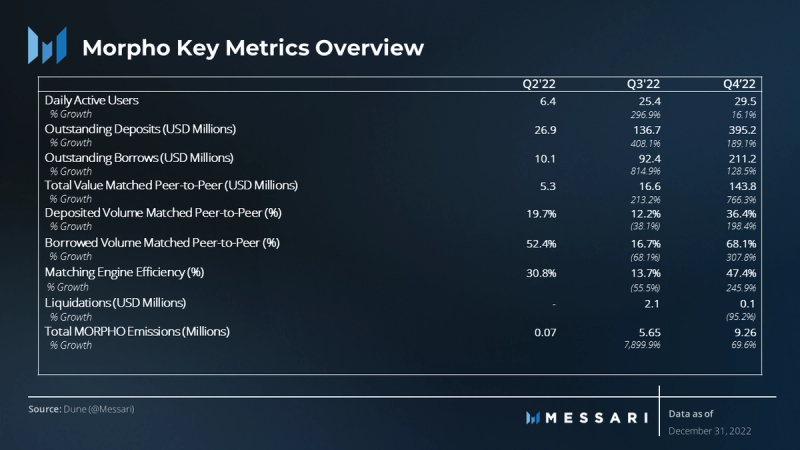
Performance Analysis
Morpho Overview

Since the June 2022 launch, Morpho’s daily active users have been relatively consistent, averaging 29.5 daily active users (DAUs) for Q4. Noticeable spikes in the daily active users can be attributed to market volatility and key market events, notably November 8-10, 20-22, and December 15-17. Additionally, new epochs began increasing MORPHO token emissions on October 24 and November 27. QoQ Morpho’s daily average users increased from 25.4 to 29.5 and reached a peak of 127 active users on December 17.
A higher number of active users is important for Morpho to support their matching engine, Caterpillar. Every time a user enters or exits a market, the matching engine will cycle through the priority queue to most efficiently match users, pairing the largest depositors and borrowers first. As a result, more users will not only provide more liquidity but overall more opportunities for users to be matched peer-to-peer.

QoQ outstanding deposits increased 189.1%, rising from $136.7 million to $395.2 million. Over the same period, borrows increased 128.5%, rising from $92.4 million to $211.2 million. Notably, deposits and borrows increased dramatically surrounding new epochs due to increased MORPHO token emissions.
As the above chart evinces, Morpho-Aave’s deposits and borrows have grown significantly larger than Morpho-Compound’s since the start of Q4. The increasing number of MORPHO rewards allocated equally to depositors and borrowers on Morpho-Aave explain this increase:
- Age 2, epoch 1 directed 300,000 MORPHO rewards to Morpho-Aave and 2.7 million to Morpho-Compound.
- Age 2, epoch 2 directed 1.19 million MORPHO rewards to Morpho-Aave and 2.21 million rewards to Morpho-Compound.
- Age 2, epoch 3 directed 1.8 million MORPHO rewards to Morpho-Aave and 1.8 million to Morpho-Compound.
From age 3, epoch 1 to age 2, epoch 3, MORPHO rewards increased 500% for Morpho-Aave and a 33% decrease in MORPHO for Morpho-Compound. Comparatively, Morpho-Aave deposits increased by 1,323% and borrows increased by 1,309% QoQ, while Morpho-Compound deposits decreased by 17.3% and borrows decreased by 32.1% for the same period. Overall, every MORPHO emitted during age 2 accounted for $78 in total deposits and borrows attracted to the protocol.
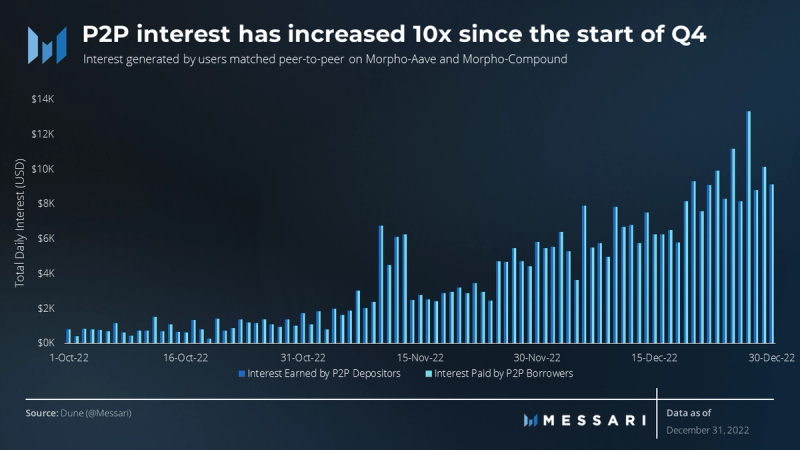
As deposits and borrows on Morpho increased QoQ, interest paid also increased. In Q3, $62,000 in interest was paid from borrowers to depositors matched peer-to-peer; in Q4, this increased to $364,000. The increase can be attributed to a general increase in the usage of the protocol as deposits, borrows, and the percentage of deposits and borrows matched peer-to-peer have all increased.
Although there was a large increase in the interest generated by loans matched peer-to-peer, by comparison, the underlying peer-to-pool matching continued to generate more interest. Depositors that were not matched peer-to-peer earned $1.1 million from the underlying pools, while borrowers that were not matched peer-to-peer paid $660,000 to the underlying pools. Considering the sharp rise in deposits and borrows matched peer-to-peer in Q4, peer-to-peer interest may surpass peer-to-pool interest in Q1.
Morpho’s Matching Engine

The percentage of deposits in the system matched peer-to-peer increased from 12.2% to 36.4%, while the percentage of borrows in the system matched peer-to-peer increased from 16.7% to 68.1%. QoQ. This accounts for a 198.4% and 307.8% increase, respectively. The matching engine efficiency increased by 245.9%, rising from 13.7% to 47.4% QoQ.
Q4 ended with $143 million in deposits and borrows matched peer-to-peer, up from just $15 million at the beginning of the quarter. Notably, $136 million of these deposits and borrows were on the Morpho-Aave instance, with the remaining $7 million on Morpho-Compound. The largest market awETH accounted for $87 million of the $143 million total borrows matched peer-to-peer.
In the protocol’s current state, the percentage of deposits or borrows matched peer-to-peer relies on market demand and general awareness of the protocol. Although further research is required, there are several ways Morpho can incentivize users to increase depositing or borrowing, such as tweaking the P2P index cursor or MORPHO reward allocation to depositors and borrowers.
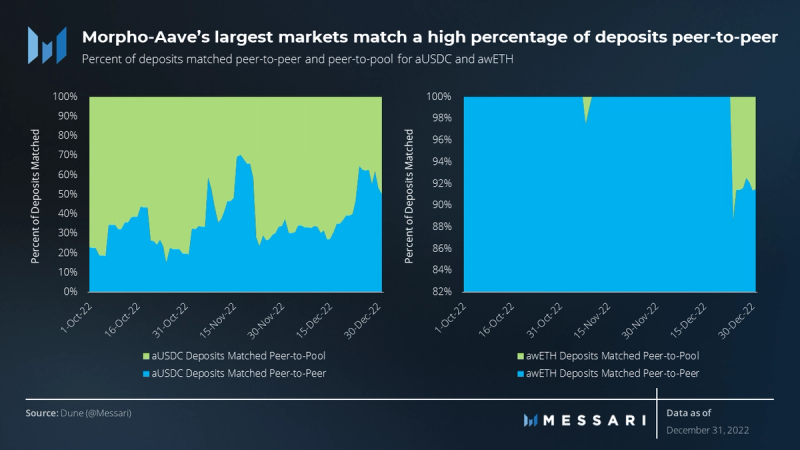
The two largest markets on Morpho-Aave are awETH and aUSDC, with the pair accounting for over $150 million in outstanding deposits and over $112 million in outstanding borrows. For a majority of Q4, over 20% of aUSDC deposits were matched peer-to-peer, and at times over 50% of deposits were matched peer-to-peer. On November 17, aUSDC deposits matched peer-to-peer reached an 85% peak.
On the other hand, the awETH market had 100% of deposits matched peer-to-peer for nearly the entire quarter, until falling to 87% matched on December 24. This is a result of a 27% increase in awETH deposits from December 23 to December 24, while borrows only increased by 12% in the same period.
Since more awETH and aUSDC are currently supplied than borrowed, new borrowers are matched peer-to-peer immediately and benefit from the more efficient peer-to-peer rate.
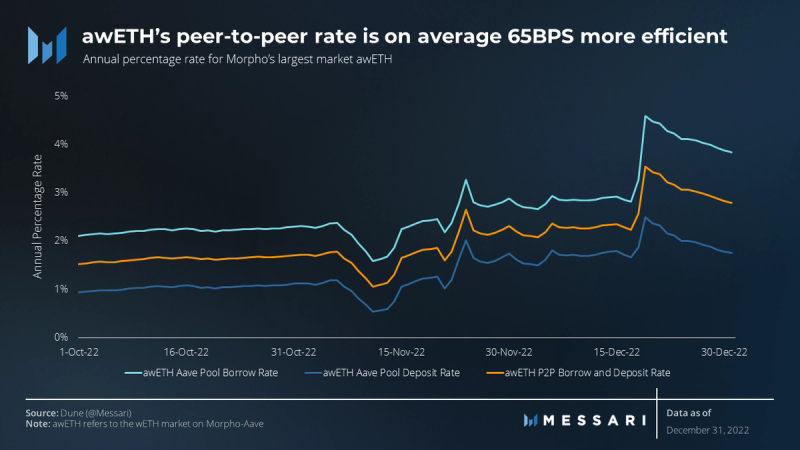
Comparatively, the APRs Morpho offers users when matched peer-to-peer are better than what is offered by the Aave or Compound peer-to-pool models. For Morpho’s largest market, awETH, users on average received a rate that was 0.65% more efficient than the underlying pool rate. Therefore, on average borrowers save 0.65% and depositors earn an extra 0.65%.
Morpho’s second largest market, aUSDC, on average offered users a 0.58% more efficient rate than the underlying pool rate. Similar improvements in APRs can be seen across all 13 of the Morpho-Aave and Morpho-Compound markets.
MORPHO Token
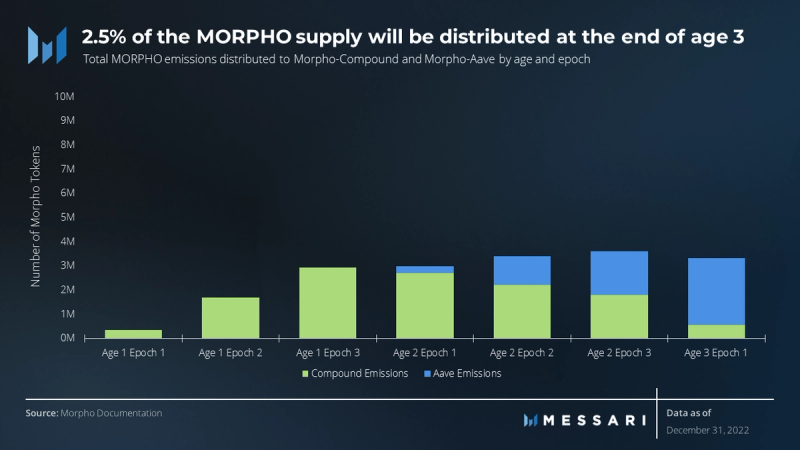
In an effort to sufficiently decentralize the protocol and bootstrap liquidity, the Morpho team has used MORPHO emissions as their primary driver. The first three ages are expected to see only 25 million MORPHO or 2.5% of the total supply emitted. Even with this small percentage of token emissions, Morpho has successfully attracted liquidity to the protocol, as evinced by the close to $400 million in outstanding deposits.
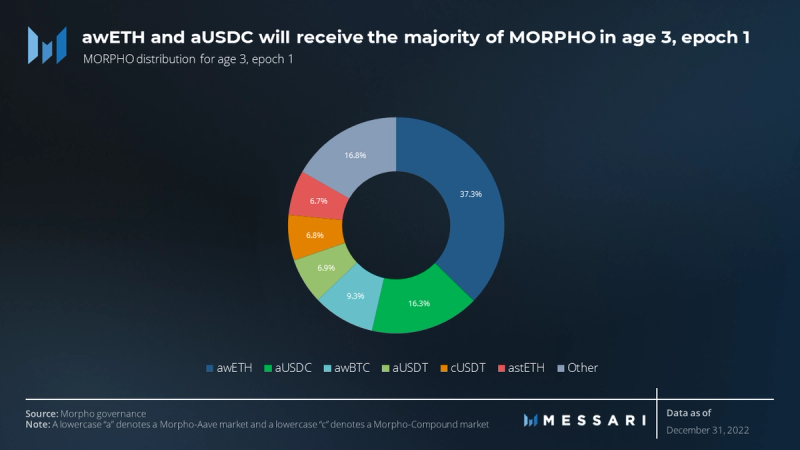
Age 3, epoch 1 is the first epoch where MORPHO has been distributed following a gauge system that was voted on by MORPHO stakeholders, deciding which markets receive MORPHO emissions based on the number of votes each market, or gauge receives. The gauge vote resulted in awETH receiving the highest number of MORPHO emissions at 37.3%, awBTC receiving the second highest at 16.8%, and aUSDC receiving the third highest at 16.3%. Historically, the awBTC pool has had low liquidity but a high percentage of deposits and borrows matched peer-to-peer. Overall, Morpho-Aave will receive 79.8% of the 3,333,333 MORPHO emissions, while Morpho-Compound will only receive 20.2%.
Qualitative Analysis
In Q4, Morpho experienced a number of project integrations in addition to the Morpho team releasing a number of updates. There were announcements for partnerships and integrations with protocols such as the following ones:
- Morphous by Mutative – Mutative is a collective of developers working with Web3 projects on their smart contract, user interface, and user experience. Mutative created Morphous, providing Morpho users with the ability to perform multiple transactions with one click.
- Volt Protocol – Volt Protocol is a decentralized credit system with a native yield-bearing stablecoin. When using mint or redeem VOLT using stablecoins, the protocol lends it in markets like Morpho.
- Origin Protocol – Origin protocol’s stablecoin OUSD is a yield-generating stablecoin, while being passively held in your wallet. Origin wishes to integrate Morpho to generate yields as they already do atop Compound.
- Instadapp – Instadapp provides users with non-custodial smart contract wallet accounts, allowing them to use complex DeFi strategies in one simple interface. With this integration, Morpho users are able to swap collateral, swap debt, deleverage, deposit, and borrow all in one click.
- StearbitDAO – Spearbit connects Web3 projects such as Morpho with independent security experts. This will allow Morpho and Spearbit to continually work together to review and audit different aspects of the protocol.
- Immunefi – Immunefi is the leading bug bounty platform for Web3 projects. Morpho has posted a reward of $555,555 for anyone who can find a critical issue in the smart contract code.
Morpho emphasized its commitment to transparency through three announcements in Q4. On December 21, Morpho made their code 100% open-source to the community. This includes over 3,000 commits going all the way back to the first day of development. Additionally, Morpho also open-sourced the repository for a liquidation bot. Although anyone can already create their own bot, this gives users a baseline to improve upon. Finally, Morpho released a blog post disassembling their matching engine, Caterpillar, describing what it is, the problem it solves, and exactly how it works.
Closing Summary
Overall, Morpho experienced a successful Q4 and the first full quarter with both Morpho-Compound and Morpho-Aave deployed. Morpho’s daily average users increased by 16.1% to 29.5 in Q4, with noticeable spikes in the daily active users due to market volatility and new epochs beginning with MORPHO token emissions. QoQ deposits also increased 189.1%, rising from $136.7 million to $395.2 million, and borrows increased 128.5% from $92.4 million to $211.2 million. The largest markets on Morpho-Aave are awETH and aUSDC, with the pair accounting for over $150 million in outstanding deposits and over $112 million in outstanding borrows.
The APRs Morpho offers users when matched peer-to-peer are better than what is offered by the Aave or Compound’s peer-to-pool model, making it significantly more cost-effective for borrowers. For example, on average, the peer-to-peer rate for awETH depositors and borrowers was 0.68% more cost-effective than the underlying pool rate, and the peer-to-peer rate for aUSDC depositors and borrowers was 0.58% more effective.
The MORPHO emissions schedule and potential improvements in the peer-to-peer index cursor will be two key areas to focus on. These tools at the Morpho team’s disposal are crucial to continue building liquidity on the protocol in addition to creating a more efficient system by matching more users peer-to-peer. The team posted proposed changes to the index cursor and the emissions schedule for age 3, epoch 2. Moving forward it will be useful to monitor the impact these changes will have on the system in Q1 and throughout 2023.





















